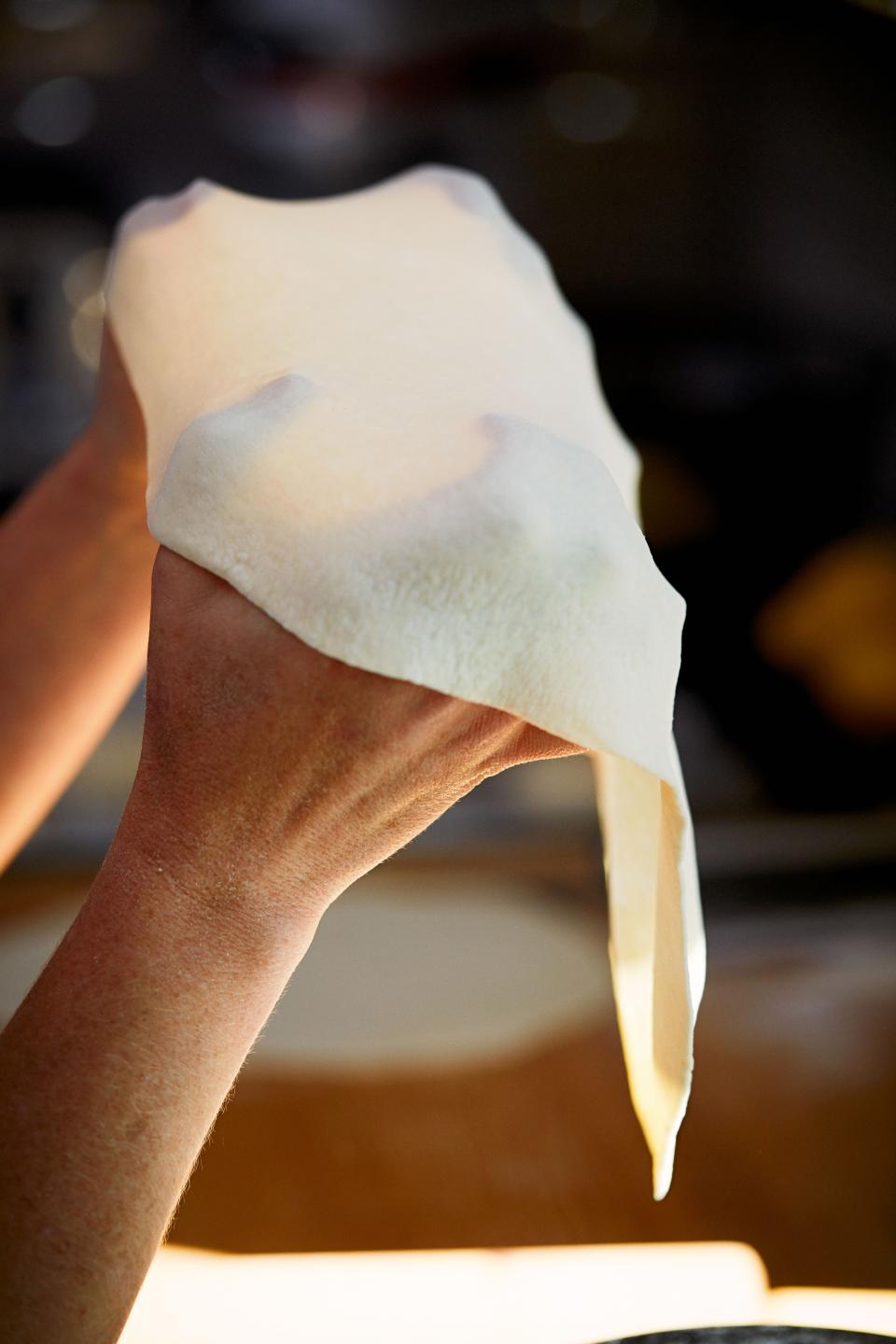Want to Make Great Flatbread at Home? Use a Wok
In Armenia, where Kate Leahy, John Lee, and Ara Zada went to learn the art of making lavash (the region's traditional flatbread), the dough is cooked in clay ovens called tonirs that drop down four feet into the earth. "If you look at it from the ground level," says Zada, "it looks like it's just a hole in the ground."
There, cooks sit around the oven, their legs tucked into notches carved into the ground around the perimeter. At one well-known bakery in Argel—a bakery, Zada says, that looks like someone just opened up their garage—the group watched a team of four women working in concert: the first baker rolling the prepared dough, the next whipping it in her hands like a pizzaiolo and stretching it onto the pillow-like device that helps to shape the dough into paper-thin sheets, the third smacking that pillow against the interior side of the tonir to adhere the dough to oven's curved surface, and the last pulling the bubbled, blistered sheet of bread from the oven and laying it on a stack of finished breads. (Lee posted a video of the process at a different tonir here if you want to check it out.)
Lavash
Back home in the States, Zada and Leahy wondered how they could even get close to replicating the chewy, blistered breads that emerged from that oven. They considered building their own tonir, but quickly realized that might be a bit aspirational for the readers of the cookbook they were writing based on their travels through Armenia.
That's when Leahy remembered walking through a market in Artsakh, a republic inside the border of Azerbaijan which was once an Armenian province and is today largely populated by Armenian nationals. There, she says, the cooks use an oven called a saj, which resembles the top of R2D2, with a domed metal top and straight sides, plus a door that opens to a wood-burning interior. She remembered the market cooks draping thin sheets of dough over the dome, then flipping the dough after a minute to cook the second side.

Lavash by Kate Leahy, John Lee, and Ara Zada - Cover
Leahy realized that the domed lid looked a whole lot like an overturned wok. So while she and Zada had success cooking their lavash on both a cast-iron griddle and a standard American grill, she set the wok upside down over her stove's gas burner, heated it up, and draped a piece of dough over the convex surface.
"I thought: Oh wow! This really works," says Leahy. Unlike cast-iron, the thin carbon steel of her wok "gets hot really quickly and cools down really quickly" which is great for temperature control, so that you don't scorch the dough as you're working through batch after batch. She warns that using a carbon steel wok is important since setting the flame of a gas oven directly against the dry surface of a coated-nonstick wok could damage the nonstick coating. And the process will only work with a gas stove. If you have electric, you'll need to stick to the grill or a cast-iron griddle (directions for both are included in their lavash recipe).

Lavash Process 2
John LeeThe quick-heating surface of the wok—combined with Leahy and Zada's recipe—makes cooking fresh homemade flatbread any day of the week a real possibility. "Since writing the book," says Leahy, "I've kept the portioned dough in my refrigerator for over five days." She says that "the longer it undergoes that secondary fermentation, the easier it is to work with."
I put that idea to the test: the recipe suggests leaving refrigerated dough at room temperature for an hour before shaping, but I've taken a three-day-old portion of dough and rolled it out straight from the fridge. It then went onto my own overturned wok (the handle turned into the stove, at Leahy's recommendation, so that it didn't heat up and damage my countertops) and bubbled and blistered beautifully in less than two minutes. A breakfast game-changer for sure.

Stretching Lavash
A few other pointers from Zada: He says that in between batches, be sure to turn off the burner. If you get the wok too hot, you'll burn the exterior of the dough before it has a chance to cook through. Leahy counters that you can easily get into a rhythm as you get more experienced, rolling out and stretching one piece of dough while another is griddling, letting a third rest if it's become too elastic to roll out further, turning the stove-top dial up or down as necessary. Keep going like that and pretty soon you'll have a stack of lavash, too—too many to eat in one sitting. But that's no matter, extra lavash are great, I'm sure you'll find some way to use them.
Bean Lavash Triangles
Originally Appeared on Epicurious



